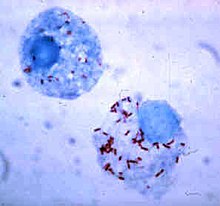| Rickettsiales | |
|---|---|

| |
| Rickettsia rickettsii (red dots) in the cell of a deer tick | |
| Scientific classification | |
| Domain: | Bacteria |
| Phylum: | Pseudomonadota |
| Class: | Alphaproteobacteria |
| Order: | Rickettsiales Gieszczykiewicz 1939 (Approved Lists 1980) |
| Families | |
| |
The Rickettsiales, informally called rickettsias, are an order of small Alphaproteobacteria. They are obligate intracellular parasites, and some are notable pathogens, including Rickettsia, which causes a variety of diseases in humans, and Ehrlichia, which causes diseases in livestock. Another genus of well-known Rickettsiales is the Wolbachia, which infect about two-thirds of all arthropods and nearly all filarial nematodes.[2] Genetic studies support the endosymbiotic theory according to which mitochondria and related organelles developed from members of this group.[3]
The Rickettsiales are difficult to culture, as they rely on living eukaryotic host cells for their survival.
- ^ Li D, Fang J, Wen B, Wua X (2021). "Molecular identification of a novel intracellular proteobacteria from scallop Chlamys farreri". Aquaculture. 539: 736565. Bibcode:2021Aquac.53936565L. doi:10.1016/j.aquaculture.2021.736565. S2CID 233921822.
- ^ Werren JH, Baldo L, Clark ME (2008). "Wolbachia: master manipulators of invertebrate biology". Nat. Rev. Microbiol. 6 (10): 741–51. doi:10.1038/nrmicro1969. PMID 18794912. S2CID 12816914.
- ^ Thomas S. (2016). Rickettsiales:Biology, Molecular Biology, Epidemiology, and Vaccine Development. pp.529. Springer•ISBN 978-3-319-46857-0